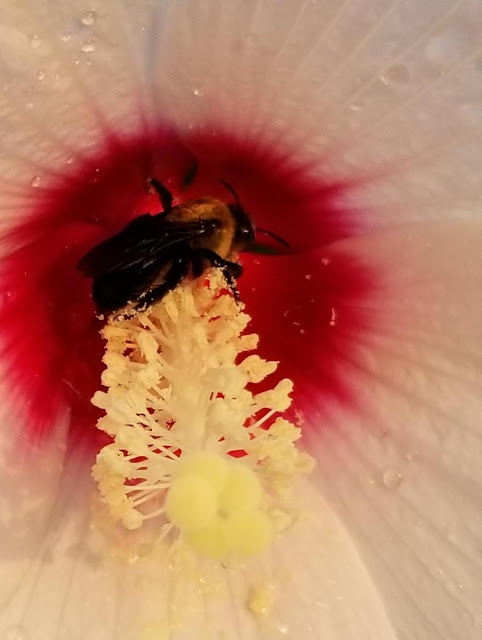
During a recent check on my pumpkin patch, something that had always been hovering around the back of my mind came forward, and I decided to check into why some flowers were producing fruit and others weren't. My first idea was that some of them were male flowers and others were female. You knew that, I'm sure. But the stumbling block for me was that they all look alike. On closer inspection, even though they look alike, they aren't borne on the same type of peduncle (or flower stalk).
Short aside here: I originally typed pedicel instead of peduncle, and in checking to make sure I was using the right term, I found I wasn't technically correct. A peduncle is the main flower stalk, and a pedicel is the flower stalk of each individual flower on a bloom made up of several smaller individual flowers.
Okay, back to the pumpkin flower...
The male flowers are all borne on long, thin peduncles:
And the female flowers are borne on short, thick stalks. The pictures below show the fruits (ovaries) already swelling atop the stubby peduncles:
And then, by happenstance, I noticed what I thought was a strange formation of the sex parts of one of the flowers, maybe a mutant:
Most of the ones I had been noticing were like this:
As it turns out, -- you guessed it -- the first picture is a female flower, and the second is a male.
Nature is amazing.
Once the flowers have served their purpose, the males simply wither up and that's that. The females, of course (if they got pollinated), fall off and leave a developing fruit behind.
I should have lots of pumpkins this fall if the weather holds, because a colony of honeybees is having a party in the pumpkin patch.
Some bunny ate most of my plants early on, and I had to replant pumpkins. I didn't have any more daisy gourd seeds, so I wasn't sure any of those survived. The vines and flowers look exactly like the pumpkin ones. And then, I spied this little fruit:
Funny looking thing. Now I know at least one gourd vine survived. It should turn out to look like one of these:
That business about male and female flowers doesn't apply to all plants. If the plant has separately sexed flowers on individual plants, it's called dioecious, from the Greek meaning two houses. That's probably the rarest arrangement, and is where they tell you that you need both male and female plants if you want flowers - or at least have a male plant within pollinating distance.
If the flowers are separately sexed, but on the same plant, it's called monoecious, or - yes, one house. And that's what plants in the cucurbit family have, which includes pumpkins, squash, zucchini, gourds, melons and cucumbers.
Then, there's another type of flower, which you no doubt have thought of - the "perfect" flower. It's perfect in this sense meaning both male and female parts exist in the same bloom. Like this hibiscus:
This is a very common type of arrangement with the anthers (the male pollen-bearing structures) surrounding the pistil (the female receptacle that leads to the ovary, the seed-bearing structure).
The hibiscus plant was the only one in the wildflower garden, and every year it struggled to compete enough to produce one stalk and a couple white flowers hidden amongst all the rudbeckia and monarda surrounding it. And then when it produced its one or two flowers, the Japanese beetles would destroy them. I dug it up and moved it to my perennial bed two years ago, and I found the flowers actually open up to these gorgeous pink tinged petals with a deep pink center. And this year, it looks like this:
This iris, too, is a perfect flower, but it's parts are much more elaborate and not so easily detected.
I'm not going to go into the whole story of the iris structure, but here's a
basic article on it if you're interested:
I normally remove all iris stems once the bloom fades, but this year I left one standing while it developed seeds:
I'll plant some out next year to see how long it takes to get a bloom from seed, and what the bloom looks like, considering this iris is a hybrid.
Double stargazers have neither anthers or pistils - no reproductive parts. So you know they have to be grown from cuttings or clones. It seems the reproductive parts formed into extra petals.
A benefit is that you don't get orange stains on your nose when you sniff them up close, or on your clothing or white tablecloth when the anthers drop. They're interesting, and they smell just as nice as normal stargazers, but I rather like the look of the graceful anthers and pistils.
Stargazers' showy reproductive parts include long thin anthers on stalks (called filaments) surrounding a long thin pistil. Well, technically, the pistil includes the stigma at the top which receives pollen from the anthers, the tubular style, and the ovary at the base.
That's all folks. Stay cool and get your covid-19 vaccinations to thwart virus mutations that seem to be popping up. Missouri is doing especially poor in this pandemic. Put your masks back on in crowds. And go outside where you don't have to wear one, and check out the flowers in your neighborhood or the wild ones in parks and countrysides.
Or...do whatever you want...just enjoy it.
 'South Africa' yellow roses, cactus zinnias, verbena boriensis and perovskia
'South Africa' yellow roses, cactus zinnias, verbena boriensis and perovskia

















































